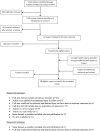The epidemiology of hepatitis C virus in the Maghreb region: systematic review and meta-analyses
- PMID: 25803848
- PMCID: PMC4372394
- DOI: 10.1371/journal.pone.0121873
The epidemiology of hepatitis C virus in the Maghreb region: systematic review and meta-analyses
Abstract
Objective: To systematically review and synthesize available epidemiological data on hepatitis C virus (HCV) prevalence and incidence in the Maghreb region and to estimate the country-specific population-level HCV prevalence.
Methods: We conducted a systematic review of HCV antibody prevalence and incidence in the Maghreb countries as outlined by the PRISMA guidelines. Meta-analyses were conducted using DerSimonian-Laird random-effect models with inverse variance weighting to pool HCV prevalence estimates among general population groups.
Results: We identified 133 HCV prevalence measures and two HCV incidence measures. Among high risk groups, HCV prevalence ranged between 22% and 94% among people who inject drugs, 20% and 76% among dialysis patients, and 2% and 51% among hemophiliacs. Among intermediate-risk groups, considerable but widely variable HCV prevalence was found. Most common risk factors cited across studies were the duration of dialysis, number of transfusions, and having a history of surgery or dental work. The national HCV prevalence in Algeria was estimated at 0.3% (95%CI: 0.1-0.5), Libya 1.2% (95%CI: 1.1-1.3), Mauritania 1.1% (95%CI: 0-2.3), Morocco 0.8% (95%CI: 0.5-1.2), and Tunisia 0.6% (95%CI: 0.5-0.8).
Conclusions: HCV prevalence in the Maghreb region of the Middle East and North Africa is comparable to that in developed countries of about 1%. HCV exposures appear often to be linked to medical care and are suggestive of ongoing transmission in such settings. Injecting drug use appears also to be a major, though not dominant, contributor to HCV transmission. Further research is needed to draw a more thorough understanding of HCV epidemiology, especially in the countries with limited number of studies. HCV prevention policy and programming in these countries should focus on the settings of exposure.
Conflict of interest statement
Figures



References
-
- El-Zanaty F, Way A. Egypt Demographic and Health Survey 2008 Egyptian: Ministry of Health. Cairo: El-Zanaty and Associates, and Macro International; 2009.
-
- United Nations. United Nations, Department of Economic and Social Affairs Population Division, Populationa Estimates and Projections Section 2010 [cited 7/11/2012]. Available from: http://esa.un.org/unpd/wpp/unpp/panel_population.htm.
Publication types
MeSH terms
Substances
LinkOut - more resources
Full Text Sources
Other Literature Sources
Medical

